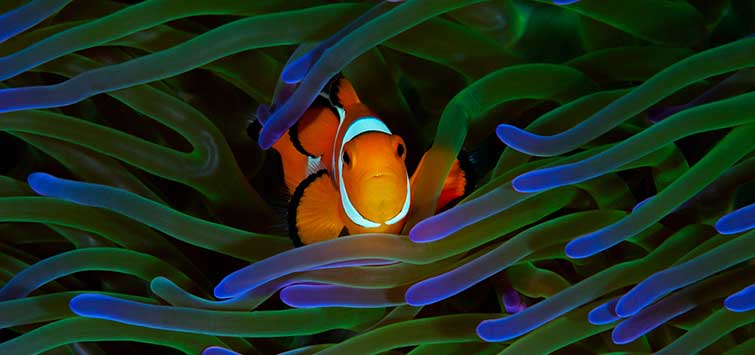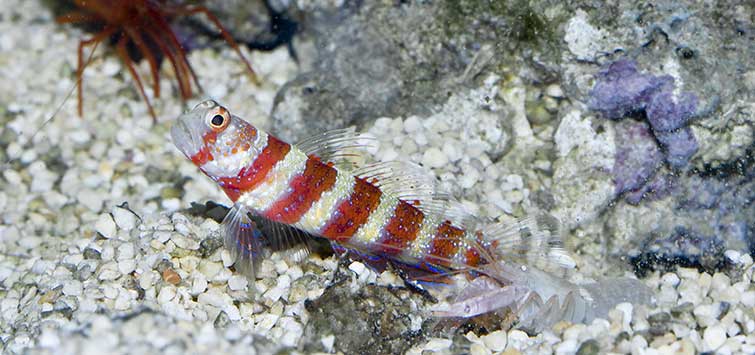The Salt Creep: So Happy Together! Symbiosis in the Marine Aquarium
Author: Jeff Kurtz
Coral reefs are extremely crowded places. Elbow room is at such a premium and competition is so fierce in the coral reef environment that many reef dwellers have evolved interesting, endearing, wonderful, or, in some cases, downright bizarre symbiotic relationships that help them make the most of their limited resources and/or avoid predation. And, perhaps not surprisingly, it’s often these fascinating symbiotic relationships that attract people to the marine aquarium hobby.
My Saltwater Conversion
Your humble Salt Creep, just like so many other hobbyists, first got the bug to set up a marine aquarium after seeing a clownfish nestled among the swaying tentacles of its host anemone—at Chicago’s Shedd Aquarium some 20 years ago, if memory serves. Don’t ask me which species of clownfish or host anemone I saw. It’s been such a long time that I can’t remember. Strictly a freshwater hobbyist at the time, I recall being utterly enthralled and thinking, “Wow! This puts any freshwater display I’ve ever had to shame!” Incidentally, it was also at the Shedd that I first laid eyes on another favorite symbiotic species, the blood shrimp Lysmata debelius, one of the cleaner shrimps.
Forms of Symbiosis
Okay, I’ve used the term “symbiotic” three times now without explaining what it actually means. Most readers will recall the term “symbiosis” from biology class, but a brief recap might be helpful to those of us who haven’t seen the inside of a classroom in a while. Merriam-Webster defines symbiosis as “the living together in more or less intimate association or close union of two dissimilar organisms.” More simply put, symbiosis is “two different species living together.”
We often mistakenly assume that symbiosis always benefits both species involved, but that’s true of only one form of symbiosis, known as mutualism. The other two forms are commensalism, in which one species benefits from the interaction while the other is neither helped nor harmed, and parasitism, in which one species benefits while the other is actually harmed.
With those clarifications in mind, let’s take a closer look at some of the symbiotic relationships marine aquarists might encounter in the hobby or be tempted to recreate in their systems. If you’re new to the marine aquarium hobby, it’s important to be aware that some such relationships are extremely difficult, if not impossible, to sustain in captivity while others can be recreated with the right effort and setup.
The Clownfish/Anemone Conundrum
The intriguing symbiosis of clownfish and anemones is one of those iconic images of the sea, recognizable even to children (no doubt due in large part to the Disney movie Finding Nemo).
Symbiosis
In the wild, clownfish, also known as anemonefish, are always found in close association with anemones, nestling within the protective “arms” of their stinging tentacles. Without the protection of a host anemone, clownfish, with their clumsy swimming habits, would be “sitting ducks” to any fish-eating predator strafing the reef. In return for this protection, clownfish, which are remarkably aggressive given their diminutive size, drive off species that may be inclined to nibble on the anemone. They’ve also been observed delivering food items to the waiting tentacles of their host.
Complicated Science
Just how clownfish are able to reside among the tentacles of anemones without harm while other fish would be stung to death is not exactly settled science. Some experts suggest that clownfish modify the chemical signature of their mucus coat to resemble that of the anemone by brushing against the anemone’s tentacles, thereby making the clownfish chemically indistinguishable from the anemone and, hence, unrecognizable as either prey or predator. Other possibilities include the theory that the mucus coat of the clownfish is inert to begin with and, therefore, doesn’t trigger an aggressive response or that the clownfish somehow adjusts its chemical signature on its own. However they do it, the resulting symbiosis is one of the more endearing relationships to observe in the coral reef setting.
Don’t Keep Clownfish with Anemones
If, as in my case, clownfish/anemone symbiosis was what motivated you to get involved in the marine aquarium hobby, a little research into the subject will (if it hasn’t already) lead you to the sobering conclusion that keeping clownfish and their natural host anemones together in an aquarium is virtually unattainable. The clownfish themselves are generally quite hardy in captivity—especially when you purchase captive-raised specimens. Their natural host anemones, on the other hand, have a dismal survival record in aquariums, seldom lasting more than a few years under even the best of conditions. For an animal that can reportedly live for centuries in the wild, this abridged life span is simply unacceptable.
The good news is that clownfish kept in captivity will do just fine without a host anemone. In fact, lacking an anemone, it’s not uncommon for these fish to adopt other sessile invertebrates, including various large-polyp stony corals, mushroom polyps, soft corals, and tridacnid clams as surrogate hosts. But even lacking a surrogate, a clownfish can lead a healthy, happy life in an aquarium setting.
A Prickly Protector
Though not as familiar to hobbyists as the clownfish/anemone symbiosis, an (almost) equally fascinating relationship exists between the Banggai cardinalfish Pterapogon kauderni and a species of long-spined sea urchin Diadema setosum (fishbase.org). In this case, however, the symbiosis seems to be commensal, as only the cardinalfish appears to benefit from the association.
And it’s easy to see how the cardinalfish benefits. P. kauderni sports vertical black bars against a silver background, which allows the fish to camouflage itself perfectly among the long, black spines of the urchin in which it hides when threatened. Even if the predator spots the cardinalfish, the urchin’s sharp, venomous spines will likely discourage it from making any serious attempt to eat it.
Does It Work in the Home Aquarium?
What’s great about this symbiotic relationship is that it’s much easier than the clownfish/anemone relationship to replicate in the home aquarium as both the Banggai cardinalfish and the long-spined sea urchin are quite hardy and adapt well to aquarium conditions. Just be aware that the long-spined sea urchin does have a few drawbacks to consider. For one, it may feed on various sessile invertebrates and, so, is not suitable for reef aquariums. For another, those long, needle-like, venomous spines can inflict a really painful sting, so the utmost care is required in managing these urchins.
In larger systems, P. kauderni can be kept in a group, which makes for a stunning display. In smaller systems, however, intraspecific aggression is more likely to become a problem, so the old one-fish-to-a-tank rule applies.
Aquarium Breeding
It’s also interesting to note that P. kauderni is one of the few marine species that will breed relatively easily in the home aquarium and that the males of the species will brood the young in their mouths until they reach the free-swimming stage. Hence, captive-bred specimens are not hard to come by, and conscientious hobbyists should request them from their dealers rather than wild-caught specimens.
Keeping It Clean
Cleaning behavior is another fascinating form of mutualistic symbiosis that is exhibited by a variety of reef organisms, such as certain wrasses, gobies, and, of course, the cleaner shrimps. Some fish species, including certain angelfish and butterflyfish, play the role of cleaner only while juveniles.
Cleaning Stations
Many reefs feature established “cleaning stations,” where various cleaner species congregate to provide their services and their aquatic customers line up to be picked clean of parasites and dead tissue. Large, predatory fishes will even suspend their natural feeding instincts to be cleaned, allowing “bite-size” cleaners to pick around inside their mouths without the threat of being gobbled up.
Cleaner Species
The cleaner species that is perhaps most familiar to hobbyists is the bluestreak cleaner wrasse Labroides dimidiatus, which is often seen on underwater nature films in association with large predatory fish, such as groupers. While it might be tempting to try to recreate this fascinating symbiosis in the aquarium, it’s best to resist the urge. L. dimidiatus and the other members if its genus have a very poor captive survival rate, primarily because they are highly specialized feeders and it’s virtually impossible within the confines of the average home aquarium to provide them with enough “clients” to keep them well fed.
A better option for observing cleaning behavior in captivity is to keep one of the cleaner shrimps, such as the aforementioned blood shrimp Lysmata debelius, the white-banded cleaner shrimp Lysmata amboinensis, or the peppermint shrimp Lysmata wurdemanni. All three may exhibit their cleaning behavior on fish in the aquarium to some degree, but, unlike the cleaner wrasses, they will readily adapt to standard aquarium fare, such as mysid shrimp, brine shrimp, and flake food. Hobbyists might be surprised (alarmed?) to discover that these endearing crustaceans will sometimes climb aboard and clean a human hand that is placed into the aquarium.
A Burrow Built for Two
The last symbiotic relationship we’ll explore here—though we’ve just barely scratched the surface of this fascinating topic—is between the shrimp gobies and pistol shrimps. The shrimp gobies, of the genera Amblyeleotris, Cryptocentrus, and several others, have evolved a mutualistic symbiosis with the pistol (or snapping) shrimps Alpheusspp., in which both fish and shrimp occupy the same burrow dug by the shrimp. A particular shrimp goby species is typically found living in association with a particular alpheid species.
The goby hovers at the opening of the burrow, keeping watch and alerting the shrimp whenever danger approaches. The shrimp, which is, for all intents and purposes, blind, maintains the burrow and stays in contact with its partner at all times by touching the goby with its antennae. At the first sign of trouble, both goby and shrimp retreat deep inside the burrow.
Symbiosis In the Aquarium
If you are able to get hold of an appropriate shrimp goby/pistol shrimp pair, you can easily recreate this fascinating relationship in an aquarium of fairly modest size. Just be sure to provide a sufficiently deep substrate (at least 2 to 3 inches), consisting of fine sand and broken coral rubble, to accommodate a burrow.
Also, be aware that pistol/snapping shrimps come by their common name honestly. These shrimps possess a modified pincer that produces an alarmingly loud popping sound, used to stun prey, which can be heard at quite a distance from the aquarium.

.png?h=595&iar=0&w=2781&hash=5FD5E69473BCC22199FBFA2FB71B6033)



